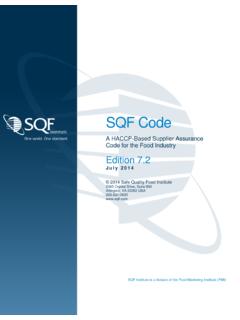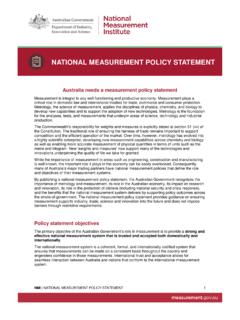Transcription of Eating at School - School Wellness Policies
1 Eating at School A Summary of NFSMI Research on Time Required by Students to Eat Lunch Martha T. Conklin, PhD, RD Director of Applied Research Laurel G. Lambert, PhD, RD, LD Research Assistant Applied Research Division national food Service management institute The University of Mississippi P. 0. Drawer 188 University, MS 38677-0188 Telephone: l-800-321-3054 April 200 1 national food Service management institute The University of Mississippi Building the Future Through Child Nutrition Location The national food Service management institute (NFSMI) was established by Congress in 1989 at The University of Mississippi in Oxford as the resource center for Child Nutrition Programs. The institute operates under a grant agreement with the United States Department of Agriculture, food and Nutrition Service.
2 The NFSMI Applied Research Division is located at The University of Southern Mississippi in Hattiesburg. Mission The mission of the NFSMI is to provide information and services that promote the continuous improvement of Child Nutrition Programs. Vision The vision of the NFSMI is to be the leader in providing education, research, and resources to promote excellence in Child Nutrition Programs. Programs and services Professional staff development opportunities and technical assistance to facilitate the management and operation of Child Nutrition Programs are provided through: + Educational References and Materials + Information services + Workshops and Seminars + Teleconferences and Satellite Seminars + Applied Research Administrative Offices Education Division The University of Mississippi Drawer 188 University, MS 38677-0188 Phone: 800-32 l-3054 Applied Research Division The University of Southern Mississippi Box 10077 Hattiesburg, MS 39406-0077 Phone: 601-266-5773 http.
3 Eating at School 1 national food SERVICE management INSTITUTEE ating at SchoolA Summary of NFSMI Research on Time Required by Students to Eat LunchIntroductionThe Applied Research Division (ARD) of the national food Service management institute (NFSMI) sponsored three studies to identify the amount of time elementary, middle, andhigh School students took to eat lunch. The most important aspect of each study was tomeasure consumption time for a School lunch. Many child nutrition professionals hadasked the question, How long does it take students to actually eat their meals? If this timewere known, School districts could factor in specific situations associated with studenttravel, service, and clean-up time to determine a lunch period that meets the needs of theirstudent population. There were no objective data on this subject; therefore, the ARDsought this information for School nutrition Were the Studies Conducted?
4 The NFSMI Applied Research Division contracted with scientists at Texas Tech Universityto conduct the first of three studies, which was completed in fall 1997. Central WashingtonUniversity and Spectrum Consulting contracted with ARD to conduct two additional studiesusing the same techniques. These studies were completed in spring 1999. Dr. AlfonsoSanchez, co-investigator on the Texas Tech research, served as technical advisor toensure techniques were similar in all three were a total of 18 schools included in the Eating at School time studies: sixelementary schools, six middle schools, and six high schools. Schools were located in fiveschool districts in four states: one district each in New York, Texas, and Washington andtwo districts in the state of were collected by means of a time study based on multiple visits to schools in allthree divisions: elementary, middle, and high School .
5 Trained research assistants usedobservation boards with attached stopwatches to record time on forms specificallydesigned for data collection. They recorded data over a 12- to 18-week period. Researchassistants observed students at the beginning, middle, and end of the lunch were timed while in the serving lines including the cashier s stations, traveling toEating at School 2 national food SERVICE management INSTITUTEthe Eating area, at the lunch tables, and while carrying or bussing their soiled trays to anarea for clean-up. Time at the lunch table was divided into Eating and socializingelements. Overall, the results of these studies represented 17,400 observations andtiming of student behavior. How Long Did It Take Students to Eat Lunch in School ?The Eating at School time studies encompassed three components: service time, time attable, and bussing time.
6 Travel or play times, associated with the meal period butoccurring outside the cafeteria, were not included in any of the TimeService time is the time it took students to choose and pick up their food and find a placeat a table to eat. This time was composed of three smaller elements: time standing in theservice line to receive a lunch tray, time standing in the cashier s line after a tray wasreceived, and time to travel to the lunch table. There was a wide range of service time among the high schools and the middle schoolsstudied. High School service time ranged from to minutes with the middle schooltime ranging from to minutes. Many variables can affect the time for serviceincluding number of students released per lunch period, number and type of serving lines,and whether students or others are allowed to cut in line.
7 The following bar charts illustratethe service time for each School division beginning with the high School Time for High SchoolsTX School 1TX School 2UT School 1UT School 2WA SchoolNY SchoolEating at School 3 national food SERVICE management Time for Middle SchoolsTX School 1TX School 2UT School 1UT School 2WA SchoolNY Time for Elementary SchoolsTX School 1 & 2*UT School 1UT School 2WA SchoolNY School Data averaged in original studyElementary School students spent the least amount of time for service with a range of minutes from the time they entered the cafeteria service line to the time they reachedthe lunch table. The majority of elementary schools used a staggered release schedulewhere a limited number of students were sent to the cafeteria at set time intervals. Eating at School 4 national food SERVICE management INSTITUTETime at Table The second component, time at table, was the time available in the lunch period for eatingin the School dining area.
8 Time at table was divided into two smaller elements: Eating andnon- Eating or socializing. Students either ate or socialized while at the lunch tables. Eating time was defined as the chewing of food and the drinking of beverages. If studentsstarted to talk with friends halfway through a sandwich, the stopwatch was halted andresumed only when they went back to Eating or drinking. More time was spent Eating than socializing, except in Texas where the lunch period waslonger. Eating time for students in all grades ranged from minutes in New York to in Texas. These findings were consistent across School divisions in allparticipating districts. The following bar charts illustrate the average Eating time forstudents in each School by Time for High SchoolsTX School 1TX School 2UT School 1UT School 2WA SchoolNY Time for Middle SchoolsTX School 1TX School 2UT School 1UT School 2WA SchoolNY SchoolEating at School 5 national food SERVICE management Time for Elementary SchoolsTX School 1TX School 2UT School 1UT School 2WA SchoolNY SchoolTime spent at the table socializing with other students ranged from minutes inWashington to minutes in Texas.
9 Socializing time at the lunch table was consistentamong the districts with the exception of Texas. This district had a longer lunchtime andrequired the students to stay in the dining area. In another state, students at the schoolwere fed in the classroom and held in their seats until released by the teacher. The total time at table for all grades ranged from to minutes. The lowest timewas recorded in a high School in Washington and the highest time was observed in a highschool in Texas. The Eating time for all students was very consistent. Socializing timeappeared to change in direct relation to the amount of time allotted for the lunch did not hold true for the time spent in Eating . Segmented bar charts for each schooldivision at Table for High Schools010203040TX1TX2UT1UT2 WANYS choolsMinutesSocializingEatingEating at School 6 national food SERVICE management INSTITUTETime at Table for Middle Schools0510152025TX1TX2UT1UT2 WANYS choolsMinutesSocializingEatingTime at Table for Elementary Schools0102030TX1TX2UT1UT2 WANYS choolsMinutesSocializingEatingBussing of Lunch TraysThe third component in the " Eating at School " time studies was the bussing of lunch trays.
10 In all schools, the time students took to carry their soiled trays to an area for clean-up wasless than one minute. High School students time in this category ranged from 11 to 45seconds. Middle School students required 17 to 35 seconds to bus their trays. As mightbe expected, elementary School students took the longest time, ranging from 27 to 52seconds to bus trays. Eating at School 7 national food SERVICE management INSTITUTEWhat Type of School Nutrition Programs Participated in the Studies?The eighteen schools selected for the study included both rural and urban settings. Thenumber of students Eating lunch varied considerably, ranging from a small School serving137 students to a large School serving 950 students (see chart below).All schools participated in the national School Lunch Program.






